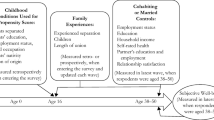Abstract
This paper revisits the marriage and wellbeing relationship using variables reflecting marriage quality and data from the US, the UK and Germany. People in self-assessed poor marriages are fairly miserable and much less happy than unmarried people, even in the first year of marriages. However, people in self-assessed good marriages are even happier than the literature suggests. Women show greater range of responses to marriage quality than men. The effect of employment status and subjective health on happiness and the marriage effects on interpersonal trust and mental health change dramatically when marriage quality is controlled for. A strong link from happiness to marriage does not exist. However, happier people are more likely to stay single instead of being unhappily married, but less likely to stay single compared to being very happily married and happiness cannot predict staying single versus being pretty happily married.



Similar content being viewed by others
Notes
In the paper we use the terms “happiness” and “life satisfaction” interchangeably. One data set which we know of, the European Social Survey, has measures of both variables; we computed the correlation coefficient between them and found it to be 0.72 (author’s calculations).
See Table 1 for the previous findings on the married dummy using different estimation methods and datasets.
See Ross et al. (1990) for a review.
We have omitted observations with the responses “Don’t know”, “No answer” and “Not applicable”, of which there were less than 10 %.
This is an acceptable procedure given that there are no repeated observations.
For further information on BHPS, see http://www.esds.ac.uk/longitudinal/access/bhps/L33196.asp.
For further information on the GSOEP, see http://panel.gsoep.de/soepinfo2011/.
We define married as a person living with a partner. We separate the effects for legally married and cohabitation samples in the empirical analysis.
One of the indicators used for marriage quality in this paper is satisfaction with marriage which is found to predict divorce (Frijters 2000).
For example, for the BHPS, the weight assigned to the first level of marriage quality is \(\omega _{1}=0.032\), the proportion of the sample which reports being “not happily married”.
Section 4.1 illustrates that the gender effect is unlikely to be completely accurately measured with this specification given that there are quite clearly differences between females and males with respect to the impact of marriage quality on happiness.
This approximation is the result of comparisons between the absolute sizes of the coefficients on the lowest category of marriage quality between males and females for each country.
The evidence from the demographic literature, that marital separation is more likely to be initiated by women, sits comfortably with this result. In addition, Guven et al. (2012) find that separations are mostly initiated by women who were actually less happier than their partners.
Multi-collinearity will not be an issue here since we show that the correlations among these satisfaction variables are always low.
We have around 2,035 observations where we observe couples in their first year of marriage in BHPS
That is, happier people are more likely to get married, rather than that marriage increases life satisfaction.
References
Becker, G. S. (1973). A theory of marriage: Part I. The Journal of Political Economy, 81, 813–846.
Ferrer-i-Carbonell, A., & Frijters, P. (2003). How important is methodology for the estimates of the determinants of happiness? Economic Journal, 114, 641–659.
Frey, B. S., & Stutzer, A. (2002). Happiness and Economics. Princeton, NJ: Princeton University Press.
Frijters, P. (2000). Do individuals try to maximize general satisfaction? Journal of Economic Psychology, 21, 281–304.
Graham, C. (2009). Happiness around the world: The paradox of happy peasants and miserable millionaires. Oxford: Oxford University Press.
Grundy, E., & Sloggett, A. (2003). Health inequalities in the older population: The role of personal capital, social resources and socio-economic circumstances. Social Science & Medicine, 56, 935–947.
Guven, C., & Saloumidis, R. (forthcoming). Life satisfaction and longevity: Longitudinal Evidence from German socio-economic panel. German Economic Review
Guven, C., Senik, C., & Stichnoth, H. (2012). You can’t be happier than your wife. Happiness gaps and divorce. Journal of Economic Behavior & Organization, 82, 110–130.
Kiecolt-Glaser, J. K., & Newton, T. L. (2001). Marriage and health: His and hers. Psychological Bulletin, 127, 472–503.
Layard, R. (2005). Happiness: Lessons from a New Science. New York: Penguin Press.
Ross, C. E., Mirowsky, J., & Goldsteen, K. (1990). The impact of the family on health: The decade in review. Journal of Marriage and Family, 52, 1059–1078.
Stutzer, A., & Frey, B. S. (2006). Does marriage make people happy, or do happy people get married? Journal of Socio-Economics, 35, 326–347.
Waite, L. J. (1995). Does marriage matter? Demography, 32, 483–507.
Waite, L. J., & Lehrer, E. L. (2003). The benefits from marriage and religion in the United States: A comparative analysis. Population and Development Review, 29, 255–275.
Author information
Authors and Affiliations
Corresponding author
Electronic supplementary material
Below is the link to the electronic supplementary material.
Rights and permissions
About this article
Cite this article
Chapman, B., Guven, C. Revisiting the Relationship Between Marriage and Wellbeing: Does Marriage Quality Matter?. J Happiness Stud 17, 533–551 (2016). https://doi.org/10.1007/s10902-014-9607-3
Published:
Issue Date:
DOI: https://doi.org/10.1007/s10902-014-9607-3




